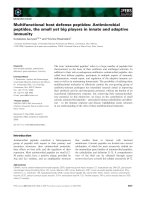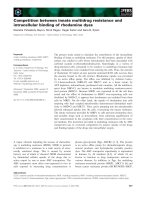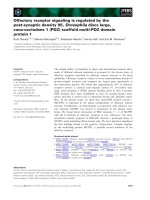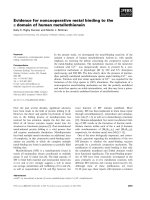Tài liệu Báo cáo khoa học: "From HOPE en I''''ESPERANCE On the Role of Computational Neurolinguistics in Cross-Language Studies " pptx
Bạn đang xem bản rút gọn của tài liệu. Xem và tải ngay bản đầy đủ của tài liệu tại đây (457.89 KB, 5 trang )
From HOPE en I'ESPERANCE
On the Role of Computational Neurolinguistics in Cross-Language Studies I
Helen M. Gigley
Department of Computer Science
University of New Hampshire
Durham, NH 03824
ABSTRACT
Computational neurolinguistics (CN) is an
approach to computational linguistics which in-
cludes neurally-motivated constraints in the
design of models of natural language processing.
Furthermore, the knowledge representations in-
cluded in such models must be supported with
documented behaviorial ev~ce, normal and patho-
logical.
This paper will discuss the contribution of
CN models to ~the understanding of linguistic
"competence" within recent research efforts to
adapt HOPE (Gigley 1981; 1982a; 1982b; 1982c;
1983a), an implemented CN model for "under-
standing" English to I'ESPERANCE, one which "un-
derstands" French.
I. INTRODUCTION
Computational Neurolinguistics (CN) incorpor-
ates initial assumptions about language processing
that are often indirectly referenced in other
computational approaches to language study. These
assumptions focus on neural-like computational
mechanisms (Ballard 1982; Feldman 1981; Gigley,
1982a; 1982b; 1983a; McClelland and Rumelhart,
1981) which subserve language behavior (Lavorel
and Gigley, 1983).
Furthermore, CN approaches to different
aspects of language processing include extensive
use of behavioral data. Research exists within
the CN paradigm along various behaviorally defined
dimensions. These are at the level of phonetic
speech studies that simulate speech errors (Le-
cours and Lhermitte, 1969; Reggia and Sanjeev,
1984), a model of aphasic language production,
JARGONAUT, (Lavorel, 1982), as well as within
lesionable models at a neural network level.
These latter models simulate association, dis-
crimination, and recognition of patterns employing
associative network models that have been tuned or
have adaptively learned to relate certain dis-
criminations (Gordon, 1982; Wood, 1978; 1980).
IThe research described in this paper was sup-
ported by an NIH-CNRS research exchange grant
entitled "Computational Neurolinguistics" and was
undertaken at Laboratoire de Neuropsychologie
Exp~rimentale, INSERM-Unit~ 94, BRON, France.
There is much philosophical and linguistic
discussion of the nature of the representations
that exist in humans and form the basis of our
cognitive function. We will not present the
debate here, but instead will claim that the CN
models we build include the assumption that the
internal representation of concepts, words, and
phonemes are given by the overall activation state
of the "network" representation within the system
at a moment in time. Furthermore, this means that
unless activations are interpreted externally (in
our case by labels so that we can talk about
them), they in and of themselves reflect the
"mental" representation.
To this end, CN models present time-
synchronized snapshots of an interactive, paral-
lel, distributed process that are interpreted to
represent hierarchies of linguistic knowledge that
can be distinguished during processing, such as a
recognized word, a grammatical interaction, or
even a disambiguated meaning.
Before turning to our efforts to adapt a
working implementation within the CN paradigm,
HOPE, into one that can process French with equal
facility, I'ESPERANCE, we will present necessafy
background to illustrate why focusing on the
"process" of language, as it can exist, based on
our current understanding of brain function,
contributes significantly to our increased under-
standing of representations which have been de-
fined within linguistics, psycholinguistics,
neurolinguistics, and AI approaches to language
study.
2. FOCUS ON PROCESS
In developing CN models, the claim is that by
focusing on process independently from repre-
sentation, we gain several perspectives that are
unattainable from other more usual approaches. CN
models include processing which is neurally
plausible. Language is seen as the behavioral
result of an interactive, time-dependent process.
This frees us from pre-specifying either all
"correct" linguistic possibilities for constraint
satisfaction at all levels of representation, or
all possible errors or recognized omissions as in
more flexible approaches (Hayes and Mouradian,
1981; Kwasny and Sondheimer, 1981; Lehnert, Dyer,
Johnson, Yong, and Hurley, 1983; Weischeidel and
Black, 1980).
452
We utilize what has been discovered by these
other approaches to be the most likely, most
plausible set of relevant features to tune our
"normal" model. Through interconnections at a
metalinguistic level, between recognized phonetic
word representations, grammatical aspects of
meaning, and specific referential meaning for
disambiguated words, CN models must tune the
process so that asynchronously activated in-
stantiations at these interpretable levels which
result from local contextual recognition achieve
the same behavioral results that are defined
within different methodologies. In other words,
we use the A! preconditions or ATN states with as
much corroboration from psychological, and
linguistic studies as is available to tune our
models for "normal" processing.
This provides an extremely valuable means of
studying processing effects in neurally motivated
"lesion" states that are consistent within our
system, and completely defined over our model of
study in a mathematical sense. This has been
discussed in detail elsewhere in Gigley (1982b;
1983a; 1983b), and Gigley and Duffy (1982) and
will not be repeated here.
3. PROCESSING ASSUMPTIONS IN HOPE
HOPE is not an acronym but was chosen as the
name of the system based on the legend of
Pandora's box. While raising many questions of
language within a new computational perspective,
it provides a first attempt to answer them as
well.
The system presents an initial attempt to
integrate AI and brain theory, BT, on two levels,
behaviorally and within processing. HOPE uses
concepts from cellular neurophysiology to define
its control. Information in HOPE is encoded in a
hierarchical graph which permits extensive
ambiquity.
For complete detail of the model with exam-
ples in "normal" and "lesioned" states the inter-
ested reader is referred to Gigley (1982a; 1982b;
1983a). We will only highlight the processing
here.
HOPE stresses the process of natural language
by incorporating a neurally plausible control that
is internal to the processing mechanism. There is
no external evaluation made to decide what happens
next. At each process time interval, there are
six types of serial-order process that can occur
and affect the state of the process. The most
important aspect of the control is that all of the
serial order computations can occur simultaneously
and affect any information that has been defined
in the model.
Similar control philosophies have been em-
ployed in letter perception by McClelland and
Rumelhart (1981), and in the connectionist
theories applied to visual processing and language
parsing (Ballard, 1982; Cottrell, 1983; Feldman,
1982; Small, Cottrell, and Shastri, 1982).
The major difference in the control in HOPE
is that the control process can be "lesioned" by
modifying parameter settings relative to their
"normal" settings to define hypothesized causes of
pathological language behavior. Example "lesions"
are changes in memory decay, elimination of a
knowledge type, and slowing of processing relative
to on-line word recognition.
Studying the results of such "lesions" and
their occurrence or not in pathological behavior
is used to further understanding of the behavior
and to suggest evolutionary changes in the model
to better its approximation to language process.
Information is presented at a phonological
level as phonetic representations of words, at a
word m~aning level as multiple pairs of designed
syntactic category types and orthographic spelling
associates, within grammar, and as a pragmatic
interpretation.
Each piece of information is a thresholding
device with memory. It has an activity value,
initially at a resting state, that is modified
over time depending on the input, interconnections
to other information, and an automatic activity
decay scheme. In addition, the decay scheme is
based on the state of the information, whether it
has reached threshold and fired or not.
Activity is propagated in a fixed sense to
all aspects of the meaning of words that are
"connected" by spreading activation. (Collins and
Loftus, 1975; Quillian, 1980/73; Small, Cottrell,
and Shastri, 1982; Cottrell, 1983). Simultan-
eously, information interacts asynchronously due
to threshold firing. This is achieved by the time
coordination of asynchronously encoded serial
order processes. The serial-order processes that
occur at any moment of the process are context
dependent; they depend on the "current state" of
the system.
The serial order processes include:
I. NEW-WORD-RECOGNITION: Introduction of the
next phonetically recognized word in the
sentence.
2. DECAY: Automatic memory decay reduces the
activity of all active information that does
not receive additional input. It is an im-
portant part of the neural processes which
occur during memory access.
3. REFRACTORY-STATE-ACTIVATION: An automatic
change of state that occurs after active
information has reached threshold and fired.
In this state the information can not affect
or be affected by other information in the
system.
4. POST-REFRACTORY-STATE-ACTIVATION: An auto-
matic change of state which all fired in-
formation enters after it has existed in the
REFRACTORY-STATE. The decay rate is differ-
ent than before firing.
453
5. MEANING-PROPAGATION: Fixed-time spreading
activation to the distributed parts of
recognized words ' meanings.
6. FIRING-INFORMATION-PROPAGATION: Asynchronous
activation propagation that occurs when
information reaches threshold and fires. It
can be INHIBITORY and EXCITATORY in its
effect. INTERPRETATION is a result of acti-
vation of a pragmatic representation of a
disambiguated word meaning.
It is the in interaction of the results of
these asynchronous processes that the process of
comprehension is defined.
The processes are independent of the know-
ledge representations defined and are blindly
applied across all of them. This often produces
unexpected but humanly interpretable results when
the end state is compared with suitably defined
behavioral test results.
During processing, we can study both the
change in state that results over time and "how"
the change occurred. Analyzing both aspects of
the process is the focus of comparison between
"normal" and "lesion" performance of the model.
In this way we are able to study the effect of the
"lesion" in a well defined linguistic context, and
to make behavioral predictions that can be veri-
fied (Gigley, 1982b; 1983a; 1983b; Gigley and
Duffy, 1982).
4. FROM HOPE en I'ESPERANCE
Given that CN approaches to natural language
processing assume a neural-like control paradigm,
it is possible to assume that such a paradigm will
work equally well for other natural languages by
simply recoding the representations into the
second language surface representation, grammar,
and semantic structure. We assume that the pro-
cesses can be tuned to produce "normal" results as
they have been for the simple English fragment
demonstrated to date.
As a first attempt to determine if such a
cross-linguistic adaptation is possible, we have
begun to redefine the knowledge representations to
encode suitable representations of French, homo-
logous to those that HOPE includes in its present
level of implementation.
The beginnings of the adaptation raised
questions about language representation from a
different perspective than occurs within a
strictly linguistic analysis. The remainder of
the paper focuses on our initial work in the
adaptation (Gigley, 1984). As the research is
currently underway, the discussion will raise
several unanswered questions in pointing out the
value of applying a CN methodology to cross-
linguistic study.
In explaining the representation issues for
French, we will first, briefly provide background
in current linguistic research on French. This
will include an overview of recent relevant
psycholinguistic and neurolinguistic studies in
French. Then we will present an overview of
computational natural language systems for speech
recognition comprehension and automatic transla-
tion into French. One issue, how to chunk French
into a phonetic representation of words, along
with the implications of the determined repre-
sentation for our processing approach to compre-
hension of French, will form the basis of the
discussion.
4.1 Word Boundaries in On-Line Comprehension
of French
Because of the parallel activation of all
meanings of each recognized word in HOPE, the
determination of the phonetic representation of a
recognized word determines the breadth of active
competition amon 9 meanings for subsequent time
intervals of the process. Depending on how the
words are chunked, different homophone sets, sets
of associated meanings for a given homophone, may
arise.
For spoken English, word boundaries tend to
be marked by intonation or pauses. However, for
French this is not the case. Depending on the
context, the ending of one word may be phone-
tically affixed to the following one called
liason. In addition, when a content word begins
wl~ vowel or silent h, the ending vowel of the
preceding word is dropped, called elision.
The problem is particularly evident with
respect to the use of articles which are very
often spoken in such context. In addition, these
same articles do not have the same meaning as they
do in English. "Le, la, les" do not always mean
"the" in the definite sense, but are often generic
and mark masculine, feminine, or plural (Gross,
1977; Goffic and McBride, 1975). And furthermore,
these same articles often are not translated into
meaning preserving sentences in English. An
example sentence demonstrating this is: Ce singe
aime le cafe. (This monkey likes coffee.)
The degradation of these same morphemes has
also been associated with certain types of aphasic
behavior in English speaking patients, speci-
fically in agrammatics and Broca's aphasics.
French neurolinguistic studies have documented a
similar degradation in the ability of agrammatic
and Broca's aphasics (LeCours and Lhermitte, 1969;
Nespoulos, 1973; 1981; Segui, Mehler, Frauen-
felder, and Morton, 1982; Tissot, Mounin, and
Lhermitte, 1973). However, only the quantity of
degradation is reported. The studies discuss
performance in general and have not specifically
addressed to what extent and in what ways these
morphemes are affected as do some of the English
studies (Zurif and Blumstein, 1978; Zurif, Green,
Caramazza and Goodenough, 1976).
Because of the import of articles in language
processing, as briefly mentioned, how they are
represented is of great interest when one wants to
454
use the adapted model, I'ESPERANCE, in its "le-
sioned" state to study the linguistic results.
Finally, to further illustrate the problems
encountered in determining the phonetic repre-
sentation, examples of the implications of de-
ciding to represent the word for water, "eau,"
will be used. These implications are relevant to
automatic speech recognition as well.
The French equivalent for "some water" is "de
l'eau" which includes the generic article, le, in
an elision context. Water is spoken as l'eau even
though there is another article as above. The
question becomes should the phonetic representa-
tion be defined as "l'eau" or as the content word
in isolation, "eau?" The decision affects the
homophone set association and will affect the
entire across-time processing in any defined
model.
Current descriptions of research in automatic
speech recognition for French (Pierrel, 1982;
Quinton, 1982) provide no relevant information.
The MYRTILLE II system described by Pierrel (1982)
stresses use of linguistic knowledge and includes
phonological substitutions for the same word. The
system includes alternatives for words at their
junction with other words in different phono-
logical contexts. The system described by Quinton
(1982), on the other hand, is very HEARSAY-like
and does not specifically address how these mor-
phemes are handled.
Finally, the automatic translation work for
French was consulted to see if there were any
r~levant discussions included in the systems
regarding the representations of words similar to
"eau". In Ariane-78, article constraints are
affixed as features to content words and elision
is decided in the final stage of the production of
the French sentences (Boitet and Nedobejkine,
1981). The content words are specifically marked
as beginning with vowels or silent "h". The final
stage of the process joins the marked content word
with an appropriate article to produce output
words such as l'eau. This suggests that for
comprehension, one would first recognize the unit
"l'eau" and decompose it to the article and con-
tent word with appropriate masculine/feminine
indicators (Jayez, 1982).
Initial assessment of the literature with
respect to this problem has provided little evi-
dence. The role of articles has not been studied
for French to the extent that it has for English.
Therefore, a pilot study with French aphasics was
designed to analyze if and in what contexts these
morphemes are affected.
The study includes off-line picture naming
which forces use of articles in all of the above
contexts, as well as on-line production of these
morphemes in an attempt to determine in which way
these morphemes are related to the words. Are
they unified with the word in all instances or
only in certain contexts?
Adapting a neurolinguistically motivated CN
model for a second language can be seen to moti-
vate a different type of question with regard to
the second language than occurs when one bases the
studies on English surface phenomena. This is
very important because often surface phenomena are
assumed to be more similar than warranted. What
we claim instead is that the processing is
similar, indeed universal and that we must begin
to make cross-linguistic studies that assume this
underlying commonality and at the same time can
account for the variation at the surface level.
5. SUMMARY
Within developing computational neurolin-
guistic research which assumes that we can define
cognitively based simulation models using AI
methodologies which are incorporated with neural
processing paradigms, we have demonstrated how one
can begin to study universals of language in a new
perspective.
The CN paradigm for natural language proces-
sing includes claims that new perspectives on
linguistically interpretable hierarchical repre-
sentations that arise in language behavior are
introduced by including neurally motivated pro-
cessing control as the focus of model definition
and by including behaviorially defined con-
straints, both normal and pathological.
The issues are not whether human brains work
in a universal fashion, but instead raise ques-
tions of how interpreted levels of representation,
which functionally produce similar language be-
havior need to be represented for different lan-
guages. This processing approach includes many
assumptions which are important to linguistic
theory. Furthermore, it provides a way of de-
veloping specific, verifiable questions about
behavior which are mathematically better defined
than through other methods, because it enables one
to develop a broader perspective of the questions
within an analysis of the hypothesis in the con-
text of a characterization of the "how" of the
entire behavior.
By adapting HOPE for processing French, we
furthermore claim that new perspectives on lan-
guage universals are demonstrated. And finally,
we feel that CN provides the only suitable way to
begin developing a comprehensive understanding of
a behavior as complex as language.
6. REFERENCES
Boitet, Ch. and Nedobejkine, N., Recent develop-
ments in Russian-French machine translation at
Grenoble. Linguistics, 19, 1981.
Ballard, D.H., Parameter Nets. Technical Report
TR75, Department of Computer Science, Univer-
sity of Rochester, 1982.
455
Cottrell, G.W., A Connectionist Scheme for Model-
ling Word Sense Disambiguation. Cognition an.__dd
Brain Theory, 6, l, 1983.
Feldman, J.A., A Connectionist Model of Visual
Memory. Parallel Models of Associative Memory,
G.E. Hinton, and J.A. Anderson (eds.), Lawrence
Erlbaum Associates, Publishers, 1981.
Gigley, H.M., Neurolinguistically Based Modeling
of Natural Language Processing. Paper pre-
sented at the Linguistic Society of America
Association for Computational Linguistics
Meeting, New York, 1981.
Gigley, H.M., A Computational Neurolinguistic
Approach to Processing Models of Sentence
Comprehension. COINS Technical Report 82-9,
Computer and Information Sciences Department,
University of Massachusetts/Amherst, 1982.
Gigley, H.M., Neurolinguistically Constrained
Simulation of Sentence Comprehension: Inte-
grating ArtTfic Ta~ Intelligence and Brain
Theory. Ph.D. Dissertation, Unive-~sity of
Massachuetts/ Amherst, 1982.
Gigley, H.M., Artificial Intelligence Meets Brain
Theory: An Integrated Approach to Simulation
Modelling of Natural Language Processing.
Proceedings of the Sixth European Meeting on
Cybernetics and Systems Research, H. Trappl
(ed.), North-H-oTland, 1982.
Gigley, H.M., HOPE AI and the Dynamic Process of
Language Behavior. Cognition and Brain Theory,
6, l, 1983.
Gigley, H.M., Experiments in Artificial Aphasia
Dynamics of Language Processing. Poster Ses-
sion presented at the Academy of Aphasia,
Minneapolis, 1983.
Gigley, H.M., From HOPE en L'Esperance, Initial
Investigation. Technical Report 84-24, Depart-
ment of Computer Science, University of New
Hampshire, 1984.
Gigley, H.M., and Duffy, J.R., The Contribution of
Clinical Intelligence and Artificial Aphasio-
fogy to Clinical Aphasiology and Artificial
Intelligence. Clinical Aphasiology, Proceed-
ings of the Conference, R.H. Brookshire (ed.),
Minneapolis, 1982.
Goffic, P.L., and McBride, N.C., Les constructions
fondamentales du francais. Libraries Hachette
et Larousse, 1975.
Gordon, B., Confrontation Naming: Computational
Model and Disconnection Simulation. Neural
Models of Language .Processes, M.A. Arbib, ~.
Caplan, and J. Marshall (eds.), Academic Press,
1982.
Gross, M., Grammaire transformationnelle du
francais: syntaxe du nom. Larousse, Paris,
1977.
Hayes, P.J., and Mouradian, G.V., Flexible Pars-
ing. American Journal of Computational
Linguistics, 7, 4, 1981.
Jayez, J H., ComprEhension automatique du langage
naturel. Masson, Paris, 1982.
Kwasny, S.C., and Sondheimer, N.K., Relaxation
Techniques for Parsing Ill-Formed Input.
American Journal oi = Computational Linguistics,
7, 2, 1981.
Lavorel, P.M., Production Strategies: A Systems
Approach to Wernicke's Aphasia. Neural Models
of Language Processes, M.A. Arbib, D. Caplan,
and J. Marshall (eds.), Academic Press, 1982.
Lavorel, P.M., and Gigley, H.M., ElemEnts pour une
th~orie gEnErale des machines intelligentes.
Intellectica, Bulletin of the ASSOCIATION pour
la RECHERECHE COGNITIVE, 7, Orsay, France,
1983.
Lecours, A.R., and Lehrmitte, F., Phonemic Para-
phasias: Linguistic Structures and Tentative
Hypotheses. CORTEX, 5, 1969.
Lehnert, W.G., Dyer, M.G., Johnson, P.N. Yong,
C.J., and Harley, S., BORIS An Experiment in
In-Depth Understanding of Narratives. Arti-
ficial Intelligence, 20, 1983.
McClelland, J.L. and Rumelhart, D.E., An Inter-
active Activation Model of Context Effects in
Letter Perception: Part I. An Account of Basic
Findings. Psychological Review, 88, 5, 1981.
Nespoulos, J L., Approche linguistique de divers
phEnom~nes d'agrammatisme. ThEse 3rd cycle,
UniversitE de Toulouse-le Mirail, Flammarion
MEdecine-Sciences, Paris, 1973.
Quinton, P., Utilisation de contraintes syn-
taxiques pour la reconnaissance de la parole
continue. Technique et Science Informatiques,
l, 3, 1982.
Reggia, J.A., and Sanjeev, B.A., Simulation of
Phonemic Errors Using Artificial Intelligence
Symbol Processing Techniques. Paper to be
given at the Seventeenth Annual Simulation
Symposium, 1984.
Segui, J., Mehler, J., Frauenfelder, U., and
Morton, J., The Word Frequency Effect and
Lexical Access. Neuropsychologia, 20, 6, 1982.
Small, S., Cottrell, G., and Shastri, L., Toward
Connectionist Parsing. Proceedings of the
National Conference on Artificial Intelligence,
Pittsburgh, 1982.
Tissot, R., Mounin, G., and Lhermitte, F.,
L'agrammatisme. Etude neuropsycholinguistique.
Dessart, Bruxelles, 1973.
Weischedel, R.M., and Black, J.E., If the Parse
Fails. Proceedings of the 18th Annual Meeting
of the Association for Computational Linguis-
t~cs~nd Parasession on Topics in Interactive
Discourse, Philadelphia, 1980.
Wood, C.C., Variations on a theme by Lashley:
Lesion experiments on the neural model of
Anderson, Silverstein, Ritz, and Jones.
Psychological Review, 85, 6, 1978.
Wood, C.C., Interpretation of Real and Simulated
Lesion Experiments. Psychological Review, 87,
5, 1980.
456









